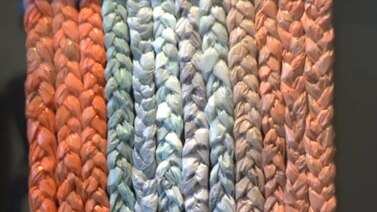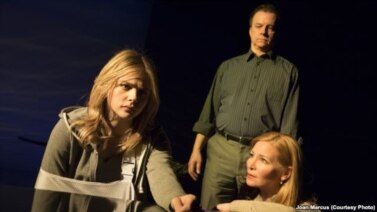
DOUG JOHNSON: Welcome to AMERICAN MOSAIC in VOA Special English.
(MUSIC)
I'm Doug Johnson.
This week we answer a question about the life of magician Harry Houdini...
We also play music by some of this year’s biggest concert money-makers...
But first, we visit the former home of one of America’s best-loved writers.
(MUSIC)
O. Henry Museum
DOUG JOHNSON: One of America's best-loved writers of short stories was William Sydney Porter -- better known as O. Henry. Beginning in eighteen ninety-three he lived with his family in a house in Austin, Texas. It is now a museum. Katherine Cole has our story.
KATHERINE COLE: Visitors to central Austin will find many huge hotels and modern buildings. It would be easy to miss one very small, old house where one of America’s favorite writers once lived. It is now called the O. Henry Museum. It was saved from destruction, moved, and turned into a museum in nineteen thirty-four. The museum is a good way to learn about the interesting life of O. Henry.
William Porter rented this house in Austin and lived there with his wife Athol and daughter Margaret for about two years. Many objects in the museum belonged to the Porters. Others did not, but are in the house to recreate the way it looked during their lifetime. Our guide takes us into the living room.
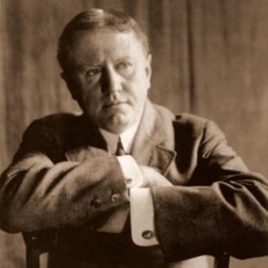
GUIDE: “Another important piece in the room is the original photograph over here. It was taken here in the house about eighteen ninety-five. The piano dates back to the eighteen sixties. And his wife took lessons on it when she first moved to Austin.”
William Porter did not start his career as a successful writer. He worked at a pharmacy, farm, land office and bank. He also loved words and writing. The museum has special proof of Porter’s love of language -- his dictionary.
GUIDE: “Very, very well used. It’s said that he has read every word in that dictionary.”
Porter started a small publication called the Rolling Stone.
GUIDE: “We have a copy of the Rolling Stone magazine. He wasn’t being published early on, so he published himself.”
His funny stories, poems, and drawings were published in the magazine. But it was too costly to continue for long, so he closed the project after about one year.
Other troubles would lead the Porters to leave Austin. Porter was accused of financial wrongdoing at the bank and lost his job. Fearing a trial, he fled the country. But he returned because his wife was dying. After her death, he faced trial and was found guilty. He served three and a half years in a federal prison in Ohio.
William Porter would keep his time in prison a secret. But there was one good thing about it. It provided him with time to write. By the time of his release, he had published fourteen stories and was becoming well-known as O. Henry.
Porter would later move to New York City and find great success there. He published over three hundred eighty stories in the last eight years of his life.
One of his most famous stories is “The Gift of the Magi.” You can hear it next Saturday, December twenty-fifth, on the Special English program AMERICAN STORIES.
(MUSIC)
The Great Houdini
DOUG JOHNSON: Our listener question this week comes from Anemina Raente Vaijero who wants to know about the life of magician Harry Houdini.
His real name was Ehrich Weisz. He was born in Budapest, Hungary in eighteen seventy-four. His father was a rabbi, a Jewish religious leader. His family moved to the United States two years later.
Young Ehrich loved show business. At the age of nine, he called himself “The Prince of the Air” as he performed on a swing high above the audience. But Ehrich always dreamed of becoming a magician.
One of his favorite entertainers was a French magician named Jean Eugène Robert-Houdin. Ehrich took his last name, changed the pronunciation, added an “i” and began calling himself Harry Houdini. At first, he performed many different kinds of magic. But in eighteen ninety-nine, he decided to spend most of his time working on “escapes.”
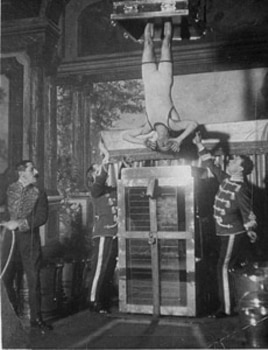
One of his most famous tricks was the “Chinese Water Torture.” His feet were locked together and he was lowered, upside down, into a glass box filled with water. A curtain was placed in front of the box so the audience could not see how he did the trick. Several minutes would go by. Just when everyone was sure the Great Houdini had drowned, the curtain would drop. There stood Houdini on the stage, free from the deadly box.
Harry Houdini also was famous for escaping from handcuffs. He said he would give one hundred dollars to anyone who could lock him into a set of handcuffs from which he could not escape. In his long career, he never had to pay the money.
Harry Houdini enjoyed a long career as a magician and escape artist. He wrote books and performed in movies. He became the most famous magician in the world. But it all came to an end on Halloween, October thirty-first, nineteen twenty-six. Houdini died after being hit several times in the stomach by a college student.
In October, the Jewish Museum in New York City opened an exhibit called “Houdini: Art and Magic.” Visitors can see old photographs, posters and videos of his escapes. They can also see some of the things he used in his magic tricks, including a straitjacket and eleven pairs of handcuffs.
Although Houdini did not believe in talking with the dead, his wife, Bess, tried to communicate with his spirit. Did she succeed? This Sunday on the Special English program PEOPLE IN AMERICA we will tell more about Houdini’s magic and how he lived and died. And we will also tell you why the words “Rosabelle, believe” are important for magicians around the world.
Big Money Music
DOUG JOHNSON: Americans attended fewer live music shows this year. And there were fewer concerts than last year. That is the report from Billboard Magazine’s yearly study of the subject.
But Billboard’s Boxscore also shows a few musicians still had some very profitable concert tours this year. Barbara Klein has more.
BARBARA KLEIN: Who made the most money this year in a concert series? Rock and roll band Bon Jovi. Billboard says it has sold more than one hundred forty-five million dollars worth of tickets. The band has played sixty-nine sold-out shows. “The Circle Tour” continues into next year. Bon Jovi will have performed in thirty countries during the series of shows.
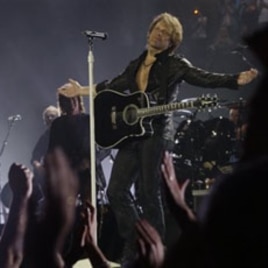
Recently, the twenty-seven year old band released a greatest hits album. Here Bon Jovi performs “I’ll Be There for You” from nineteen eighty-eight.
(MUSIC)
Lady Gaga also had a big year with her concert series. She made about one hundred ten million dollars on her tour. She performed at more than one hundred twenty shows.
Last week, Billboard magazine named Lady Gaga its Artist of the Year. Only six other women have made the list. They include names like Madonna and Taylor Swift.
Here is Lady Gaga performing her Grammy-nominated song “Bad Romance.”
(MUSIC)
Finally, the Irish band U2 also had successful concerts this year. The stage design of “U2 360” puts the band in the middle of the audience.
U2 formed in nineteen seventy-eight. It has been together even longer than Bon Jovi. We leave you with a U2 song from two thousand. Here is “Beautiful Day.”
(MUSIC)
DOUG JOHNSON: I’m Doug Johnson. Our program was written by Dana Demange, Jim Tedder and Caty Weaver, who also was our producer.
Join us again next week for AMERICAN MOSAIC, VOA’s radio magazine in Special English.
(MUSIC)
